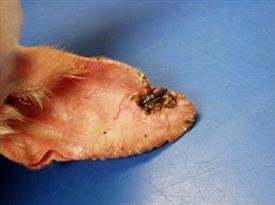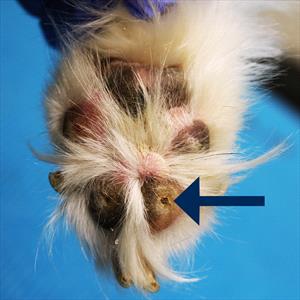Vasculitis is an inflammatory process of the blood vessels (arteries, veins, or capillaries). Cutaneous means the skin is affected. When skin blood vessels are inflamed, this is called cutaneous vasculitis. Weakened or narrowed vessels, and sometimes blood clots, decrease the flow of oxygen and nutrients to the skin. Cutaneous vasculitis is uncommon in dogs and cats.
What Does Cutaneous Vasculitis Look Like?
Signs of cutaneous vasculitis depend on the size and location of the affected blood vessels. Early cases may have only hair loss. Other signs of cutaneous vasculitis include redness, swelling, sores, and bleeding. A dog or cat with cutaneous vasculitis may only have skin changes or may also have other signs such as decreased appetite, lethargy, or fever.
Cutaneous vasculitis can cause skin changes in one place or over most of the body. Ears, tail tips, and paw pads are common sites. When a dog or cat’s ear flap (pinna) is involved, this is called pinnal vasculitis. One or both ears may have hair loss, crusts, and bleeding. When vasculitis affects a dog’s tail, tail wagging can knock scabs from the tail tip and cause bleeding. Severe cases of cutaneous vasculitis on the paw pads can lead to bleeding wounds (ulcers) in the center of the paw pads, making it painful for the dog or cat to walk. Because blood vessels in the ears and tail are small, pinnal, and tail tip vasculitis can lead to a severe block in blood flow. Parts of the ear and tail can then die off (necrosis) and appear black.
Pinnal Vasculitis (canine ear)

Pinnal Vasculitis (canine ear) Courtesy of VIN Dermatology Consultants
How is Cutaneous Vasculitis Diagnosed?
Many other skin issues look like cutaneous vasculitis. The veterinarian may take samples for skin tests to look for other causes of hair loss and crusty skin such as bacteria, yeasts, and mites. Because blood vessels are throughout the body, the veterinarian will also examine your dog and cat for other signs of vasculitis.
Several tests are then used to diagnose and determine the type of vasculitis. Different types of inflammation lead to different forms of cutaneous vasculitis.
Cutaneous vasculitis can also be a sign of another disease that is damaging blood vessels elsewhere in the body. For this reason, the veterinarian may also perform one or more of the following tests:
- Blood tests
- Urine tests
- X-rays
- Ultrasound, a noninvasive test that uses sound waves to take pictures of the body
- Skin biopsy, a test in which a small piece of skin is removed through minor skin surgery, and the blood vessels are examined under a microscope by a veterinary pathologist.
Your pet may also be referred to a veterinary dermatologist, a veterinarian who specializes in ear and skin diseases, to determine if a biopsy is necessary and for additional care.
What Causes Cutaneous Vasculitis?
Although we don’t know why vasculitis happens, sometimes vasculitis follows an infection. It may also be the result of medications, vaccinations, or food. Although frostbite can occur on the ear flaps of dogs and cats, frostbite is a different condition. Cold weather is not a common cause of cutaneous vasculitis. Sometimes, a specific cause of vasculitis cannot be determined (idiopathic).
Canine Paw Pad with Cutaneous Vasculitis Lesion

Paw Pad Lesion (canine) Courtesy of Dr. Amelia White
How is Cutaneous Vasculitis Treated?
The main goals of treatment are to stop inflammation and prevent more damage to the body while avoiding medication side effects where possible. Some cases respond quickly to one medication and then the medication can be stopped. Other cases require multiple medications before getting a good response. No matter which treatment is chosen, follow the instructions from your pet’s veterinarian.
What is the Long-term Prognosis for Cutaneous Vasculitis?
This depends on the type of cutaneous vasculitis and, sometimes, how quickly the vasculitis was diagnosed and treated. Lesions may come and go, especially as medications are adjusted. If your dog or cat continues to develop new signs of cutaneous vasculitis when medications are decreased, you may need to treat them for the rest of their lives.
The skin on the ears that has already died off (necrosis) will not grow back. Instead, there will be a scar, and part of the ear will remain missing. However, many medications can be used to manage vasculitis and prevent more damage to the skin. Diagnosing and treating the cause of the cutaneous vasculitis with your pet’s veterinarian can also make this disease easier to manage.